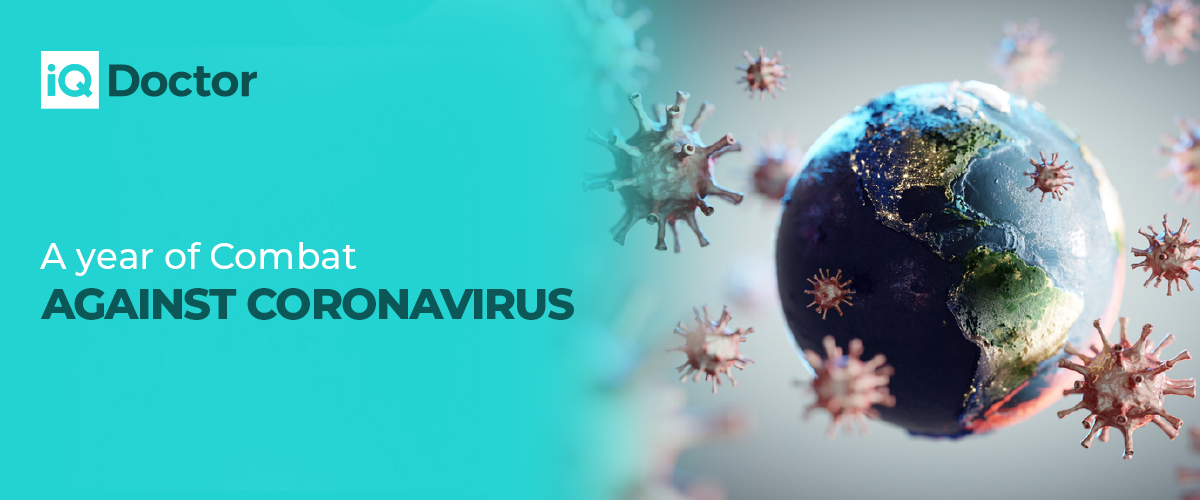A year of Combat Against Coronavirus
22 April, 2021 | Jane Thomas - Marketing

The outbreak of COVID-19 has forced everyone in the world to change their habits. We’ve changed how we eat, live and socialize; basically, our entire life. The COVID-19 outbreak was first recorded in the Chinese city of Wuhan at the end of 2019. By the start of 2020, it went on to spread across the entire world. Hundreds of countries were affected by this virus. Countries went into lockdown; people were advised to stay isolated and avoid unnecessary socialization. After a year of combat against Coronavirus, how well have we really fared?
What is Coronavirus?
Coronavirus is a virus covered in pointed protein molecules that appear like a crown. There are hundreds of known coronaviruses, but seven are known to affect humans and cause disease. The Coronavirus SARS-COV was responsible for the SARS outbreak, MERS-COV for the MERS outbreak, and SARS-COV-2 has caused the current COVID-19 pandemic. Out of the seven viruses that affect humans, four tend to cause colds. Two of these mildly infect the nose and throat, whereas the other two infect the lungs and cause a more severe illness. The seventh — the one that causes COVID-19 — has features of each of the earlier viruses and spreads quickly, severely impacting the lungs.
Viruses cannot reproduce independently; they must invade the cell and take over its processes to be able to grow and multiply. This type of Coronavirus is unlike any the world has seen before. How the virus affects an individual varies; some suffer from mild symptoms like runny nose, sore throat, cough and fever, whereas others might experience severe pneumonia. Additionally, for some people, it can even be fatal. Until now, there have been 128,950,780 COVID-19 cases reported worldwide in over 219 countries, and 2,818,911 people have lost their lives to it.
So, where did the novel COVID-19 virus originate from?
How did Coronavirus Start?
Coronavirus is a zoonotic virus that can spread from one species to another. A zoonotic virus is born when an animal is infected by two related viruses. For example, some experts believe that the 1918 Spanish Flu started when a bird with Bird Flu and a human who had seasonal flu came into contact with a pig. Those two viruses couldn’t infect each other, but both could infect the pig. The pig then infected the humans with this new virus which their immune system couldn’t recognize. This kind of contact is unlikely in natural environments.
According to experts, we’ll see more diseases like this originating in the future. The world health organization has been investigating the origin of the COVID-19 virus at the Huanan Seafood Wholesale Market in Wuhan. The head of mission, Peter Embarek told the media that their research suggests the virus probably jumped from bats to humans by an intermediary species. They also told the press that there was no indication of the Coronavirus before 2019.
Lives after Coronavirus Pandemic
When Wuhan went into lockdown in January 2020, the strict measures and restrictions shocked the entire world. However, soon after, many countries followed suit.
Italy being one of the most affected countries, went into lockdown on 9th March 2020, followed by the UK, USA, Iran, Turkey, India, Brazil and all others who had a massive surge in cases. According to scientists, it would take at least a year before the world could get the COVID-19 Vaccines. While COVID-19 kept affecting lives, scientists raced towards developing the COVID-19 Vaccine.
This virus changed the world and our way of life. Millions of people were confined to their homes, practising social distancing. Strict lockdowns were imposed, and economies came to a grinding halt. Many lost their loved ones and their jobs. COVID-19 has indeed changed our lives significantly, perhaps even irreversibly.
Precautions and Safety Measures
The world is trying to land back on its feet, trying to go back to its status before 2020 and attempting to establish what went wrong. Masks have become a necessity of life and routine articles of clothing, and that’s because masks have proven to reduce the infection rate by 75 percent.
Consequently, individuals now avoid hugs and handshakes as a precautionary measure, and likewise, sanitization has become a ritual of daily life. These preventive measures are necessary and exactly what we need to keep safe and social distanced until we get vaccinated.
Treatments and Vaccines for COVID-19
The only ray of hope the world saw after the Coronavirus hit was the creation of COVID-19 vaccines. Soon after the COVID-19 pandemic gripped the globe, scientists began developing an effective vaccine.
A vaccine trains the immune system to recognize an invader and combat it while keeping one safe. Making a vaccine is a lengthy process and has many safety standards before public vaccination.
Typically it takes ten years or more to complete the entire process. None of these steps can be missed, but COVID-19 demanded speed, and thus scientists did multiple steps simultaneously, which ensured safety and efficiency. The COVID-19 Vaccine is one of the quickest developed vaccines in history. When the virus emerged many of us heard about the term coronavirus for the very first time.
Numerous labs were put on high alert worldwide to begin working on a way out as soon as the Chinese Scientists decoded the virus’ genome and published it online.
Types of Vaccines
There are four different types of COVID-19 Vaccines, aiming to produce immunity to the COVID-19 virus.
Whole Virus Vaccines
This type of Vaccine modifies the virus to weaken or disable it. When induced in the body, it reacts with the antigen, creating immunity. It does not cause the harmful impact of an actual live virus.
Protein Subunit
Another way is to use the virus’s fragments, like the pointy-shaped protein of the COVID-19 virus. These proteins are relatively easy and cheap to produce, and these sub proteins do not infect the host cells either, thus preventing the onset of the disease. However, they are also less likely to be recognized by immune cells on their own, and hence chemical agents called adjuvants are used to stimulate the immune system.
Nucleic Acid
These types of vaccines involve inserting genetic codes into cells to produce antigens. Instead of using viruses for delivery, these vaccines insert a modified code directly into the cells, either by attaching it to a molecule or by forcing it into the cells. These vaccines are quick and cheap to develop, but they are a relatively newer technology.
Viral Vector
The goal here is to get a short fragment of genetic code — taken from a target pathogen — into the patient’s cell. These vaccines mimic the way viruses naturally reproduce during infection, producing large amounts of antigens and triggering an immune response. Viral Vector vaccines achieve this by inserting the antigen’s genetic code into a harmless virus, which acts as a delivery system to get the code into the cells without causing disease. These vaccines can be complex to develop but are incredibly effective.
Types of COVID-19 Vaccines
With hundreds of COVID-19 Vaccines in development, a mixture of different vaccine types is likely to be used. Three different vaccines have been approved by the Medicines and Healthcare products Regulatory Agency (MHRA) in the UK; they have met strict safety and quality standards. These three COVID-19 Vaccines include Pfizer/BioNTech, OxfordAstraZeneca and Moderna Vaccine. The NHS is offering vaccines to people most at risk from COVID-19, including people over the age of 50, clinically vulnerable people, care home workers, people with a learning disability, or those who are primary caretakers of vulnerable people. The vaccine is given in two doses and injected into the upper arm. The second dose is administered 3 to 12 weeks after getting the first dose.
Benefits of COVID-19 Vaccine
So far, billions of people have taken the COVID-19 Vaccine and have reported no serious side effects or allergic reactions. Some rare and mild side effects include headaches, sore arm, nausea etc., and you may also experience fever 1 or 2 days after getting your COVID-19 Vaccine. Getting a COVID-19 Vaccine will help you effectively prevent contracting the virus. Experts argue that even if you do get COVID-19, the Vaccine will prevent you from getting seriously ill. COVID-19 vaccination is an alternative way to help protect you by creating antibodies without contracting the virus. Vaccination is currently the most essential tool that can be used to put a stop to this pandemic apart from social distancing and other safety measures.
Difference Between a PCR Test and COVID-19 Vaccine
COVID-19 vaccines and PCR tests are two different entities to clear the confusion. COVID-19 Vaccines help you effectively stay immune to the COVID-19 virus, whereas PCR tests are used to detect whether you have COVID-19, or not.
PCR stands for Polymerase Chain Reaction. PCR testing is also called molecular testing, and it has been one of the most widely used COVID-19 tests worldwide. PCR tests usually take around 24 hours for the results to get processed. It can take longer depending upon where the laboratory is situated and the amount of workload they can manage. A swab is used to collect the sample from the back of the throat and then both the nostrils.
A PCR Test can get the results before the process is fully complete. This quick turn around factor has played a pivotal role in ensuring the effectiveness of the 2-week quarantine policy setup by the UK government.
If you’re looking to get yourself a COVID-19 PCR Test, iQ Doctor is the place for you. iQ Doctor is a fully, legally registered online pharmaceutical store that offers you COVID-19 RT-PCR Testing kits with two different certifications. For more details, check this out.
It is essential to get yourself and your loved ones vaccinated to stop this pandemic.
Can I Test Positive for COVID-19 After Taking the Vaccine?
If you have previously contracted COVID-19 or if you have been vaccinated, your body will contain antibodies for the COVID-19 virus. As long as you have COVID-19 antibodies, you will not test positive for COVID-19. It typically takes the body a few weeks to build this immunity, which means that a person could test COVID-19 positive before or after the vaccination.
Getting Used to the New Normal
The recent developments in the COVID-19 vaccines have given people new hope. It tells us that the future is hopeful with the advancement in science and technology. At the same time, though, this pandemic has also taught us the importance of hygiene and cleanliness. The Before Times now seem ancient in the face of social distancing, zooming and masks, which is our new normal.
Reviewed By

Omar El-Gohary
The superintendent and lead pharmacist - registration number 2059792.
Omar is passionate about developing healthcare technology to empower our patients.
Related Posts
Tags
No Tags Available


